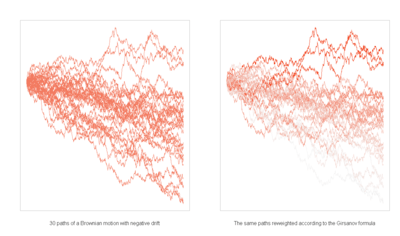Girsanov theorem

In probability theory, the Girsanov theorem (named after Igor Vladimirovich Girsanov) describes how the dynamics of stochastic processes change when the original measure is changed to an equivalent probability measure.[1]:607 The theorem is especially important in the theory of financial mathematics as it tells how to convert from the physical measure which describes the probability that an underlying instrument (such as a share price or interest rate) will take a particular value or values to the risk-neutral measure which is a very useful tool for pricing derivatives on the underlying.
History
Results of this type were first proved by Cameron–Martin in the 1940s and by Girsanov in 1960. They have been subsequently extended to more general classes of process culminating in the general form of Lenglart (1977).
Significance
Girsanov's theorem is important in the general theory of stochastic processes since it enables the key result that if Q is a measure absolutely continuous with respect to P then every P-semimartingale is a Q-semimartingale.
Statement of theorem
We state the theorem first for the special case when the underlying stochastic process is a Wiener process. This special case is sufficient for risk-neutral pricing in the Black-Scholes model and in many other models (e.g. all continuous models).
Let  be a Wiener process on the Wiener probability space
be a Wiener process on the Wiener probability space  . Let
. Let  be a measurable process adapted to the natural filtration of the Wiener process
be a measurable process adapted to the natural filtration of the Wiener process  .
.
Given an adapted process  with
with  define
define
where  is the stochastic exponential (or Doléans exponential) of X with respect to W, i.e.
is the stochastic exponential (or Doléans exponential) of X with respect to W, i.e.
where ![[X]_t](../I/m/b09ede298b85f6af03c182d75a6497be.png) is a quadratic variation for
is a quadratic variation for  . If
. If  is a strictly positive martingale, a probability
measure Q can be defined on
is a strictly positive martingale, a probability
measure Q can be defined on  such that we have Radon–Nikodym derivative
such that we have Radon–Nikodym derivative
Then for each t the measure Q restricted to the unaugmented sigma fields  is equivalent to P restricted to
is equivalent to P restricted to 
Furthermore if Y is a local martingale under P then the process
is a Q local martingale on the filtered probability space  .
.
Corollary
If X is a continuous process and W is Brownian motion under measure P then
is Brownian motion under Q.
The fact that  is continuous is trivial; by Girsanov's theorem it is a Q local martingale, and by computing the quadratic variation
is continuous is trivial; by Girsanov's theorem it is a Q local martingale, and by computing the quadratic variation
it follows by Lévy's characterization of Brownian motion that this is a Q Brownian motion.
Comments
In many common applications, the process X is defined by
For X of this form then a sufficient condition for  to be a martingale is Novikov's condition which requires that
to be a martingale is Novikov's condition which requires that
The stochastic exponential  is the process Z which solves the stochastic differential equation
is the process Z which solves the stochastic differential equation
The measure Q constructed above is not equivalent to P on  as this would only be the case if the Radon–Nikodym derivative were a uniformly integrable martingale, which the exponential martingale described above is not (for
as this would only be the case if the Radon–Nikodym derivative were a uniformly integrable martingale, which the exponential martingale described above is not (for  ).
).
Application to finance
In finance, Girsanov theorem is used each time one needs to derive an asset's or rate's dynamics under a new probability measure. The most well known case is moving from historic measure P to risk neutral measure Q which is done - in Black Scholes framework - via Radon–Nikodym derivative:

where  denotes the instantaneous risk free rate,
denotes the instantaneous risk free rate,  the asset's drift and
the asset's drift and  its volatility.
its volatility.
Other classical applications of Girsanov theorem are quanto adjustments and the calculation of forwards' drifts under LIBOR market model.
See also
References
- C. Dellacherie and P.-A. Meyer, "Probabilités et potentiel -- Théorie de Martingales" Chapitre VII, Hermann 1980
- Girsanov, I. V., "On transforming a certain class of stochastic processes by absolutely continuous substitution of measures", Theory of Probability and its Applications, 1960
- E. Lenglart "Transformation de martingales locales par changement absolue continu de probabilités", Zeitschrift für Wahrscheinlichkeit 39 (1977) pp 65–70.
External links
- ↑ M. Musiela, M. Rutkowski: Martingale methods in financial modelling. 2nd ed. New York : Springer-Verlag, 2004. Print.
- Notes on Stochastic Calculus which contains a simple outline proof of Girsanov's theorem.
- Applied Multidimensional Girsanov Theorem which contains financial applications of Girsanov's theorem.

![\mathcal{E}(X)_t=\exp \left ( X_t - \frac{1}{2} [X]_t \right ),](../I/m/9ee3a84d37dc5d1d850856e967f16d72.png)

![\tilde Y_t = Y_t - \left[ Y,X \right]_t](../I/m/b19819ff9bc30e43dcbf90a340dfa629.png)
![\tilde W_t =W_t - \left [ W, X \right]_t](../I/m/e2a1fcd630586691ee2292cc206f9023.png)
![\left[\tilde W \right]_t=
\left[W_t, W_t\right] - 2 \left[W_t, [W, X]_t\right] + \left[[W, X]_t, [W, X]_t \right] = \left [ W \right]_t = t](../I/m/fd730dee4d4554fa7c1aa5d9a959a491.png)

![E_P\left [\exp\left (\frac{1}{2}\int_0^T Y_s^2\, ds\right )\right ] < \infty.](../I/m/86920c2a504d7394b6eb2621ffa7d08a.png)
